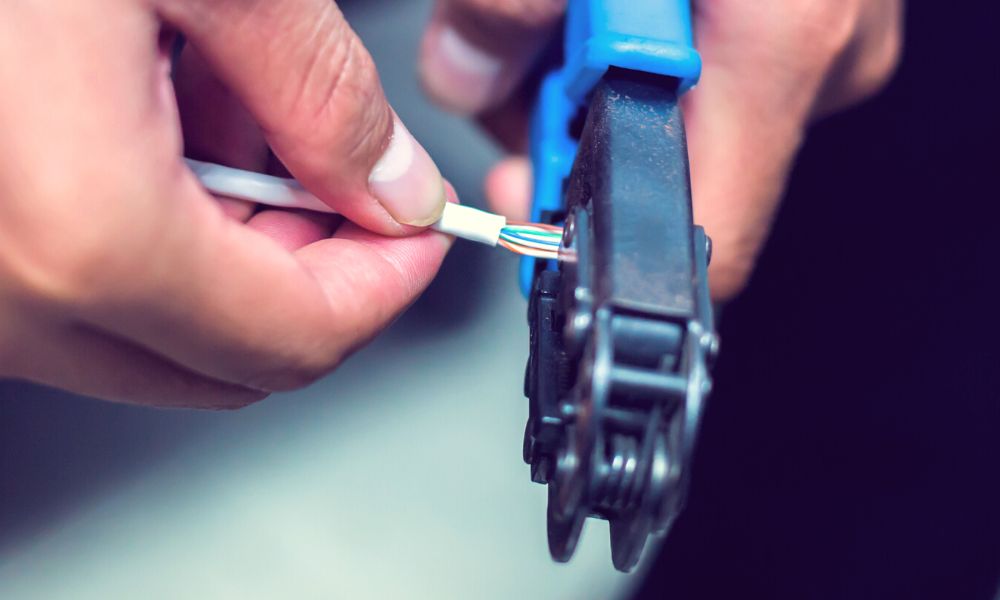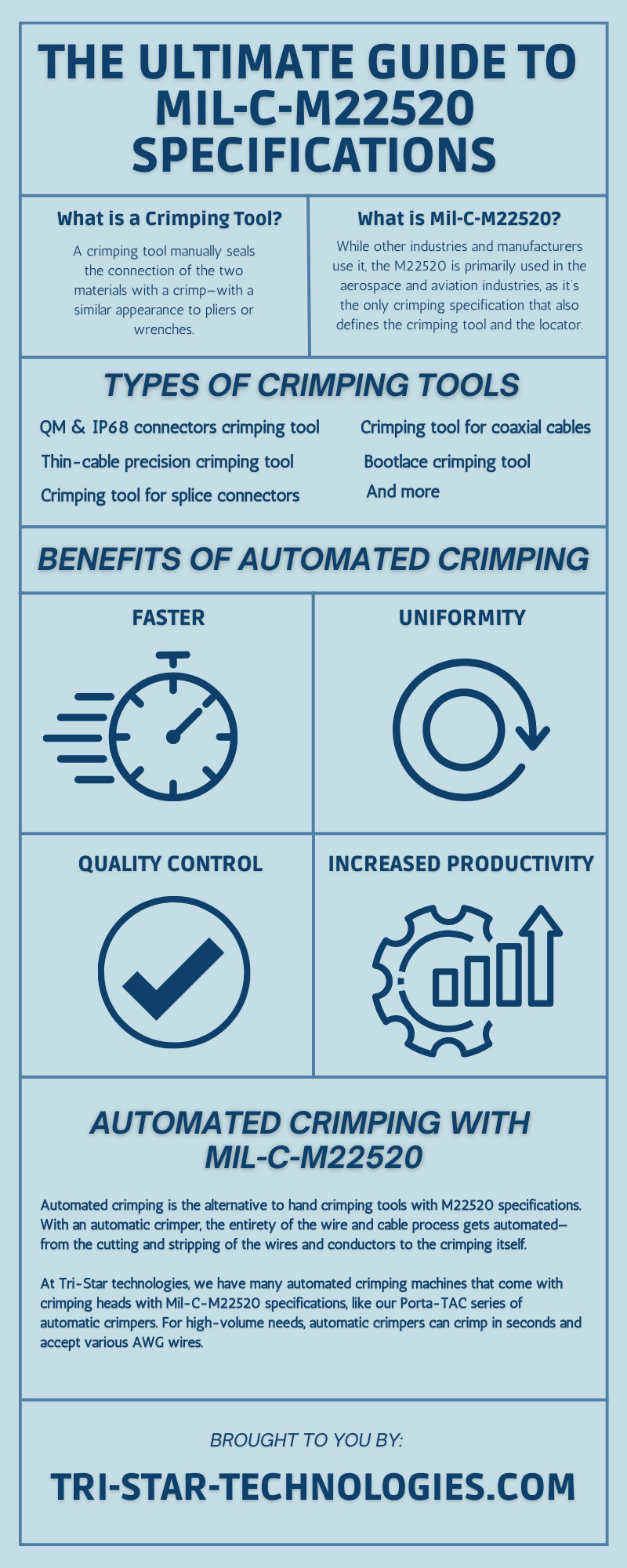The Ultimate Guide to Mil-C-M22520 Specifications

Crimping is an essential part of wire processing and electrical systems. With many crimping tools come specifications to ensure uniformity and quality, including Mil-C-M22520 specifications.
In our ultimate guide on Mil-C-M22520 specifications and crimping, we’ll take a closer look at crimping, crimping tools, and automatic crimpers—including different types of crimping tools, the benefits of automatic crimping, and more.
What is Crimping?
Mil-C-M22520 specifications are for crimping tools, so we’ll start our ultimate guide with some basic background on crimping. In simple terms, crimping is the process of safely joining pieces of metal or other materials. Crimping is typically used for conductors and other electrical components as part of electrical work.
To join the two pieces, the wires get cut and stripped to expose the metal, and then one gets deformed to hold the other. The joining of these two materials in a sealed connection is known as the crimp. Practically every industry that uses electrical components requires the crimping process to attach terminals and connect ends to electrical conductors.
What is a Crimping Tool?
A crimping tool manually seals the connection of the two materials with a crimp—with a similar appearance to pliers or wrenches. Even those who have never heard of crimping tools or know what they do has likely seen one as they’re common in practically every toolbox and workshop—regardless of industry.
The crimping tool seals the connection to prevent any gas or moisture from reaching the exposed metal, which can quickly cause shortages or faulty electrical connections that jeopardize the entire system. But because every business is different, many industries have specific crimping tools that are more useful for their application.
Types of Crimping Tools
Because crimping is integral to so many industries, many different types of crimping tools are available that best fit the application. Examples of specific crimping tools include:
- Bootlace crimping tool
- Thin-cable precision crimping tool
- QM & IP68 connectors crimping tool
- Crimping tool for splice connectors
- Crimping tool for coaxial cables
- And more
To differentiate all these hand crimping tools and what they’re used for, there are many standards and specifications that identify which tools are applicable for what settings, like the Mil-C-M22520 specification.
What is Mil-C-M22520?
Also known as just the M22520 specifications, the Mil-C-M22520 specifications are a general list of requirements—primarily for crimping tools but also applicable for other equipment electrical components like:
- Inspection gauges
- Coaxial connectors
- Ferrules
- Terminals
- End caps
- Splices to wire conductors
While other industries and manufacturers use it, the M22520 is primarily used in the aerospace and aviation industries, as it’s the only crimping specification that also defines the crimping tool and the locator.
What’s the Crimping Tool Locator?
Another crimping component is the locator, also called the turret. The primary use of the locator is to make it more versatile in its application.
As a crimping accessory, the locator attaches to the crimping tool and adapts the tool’s frame to the particular application. For aircraft applications, the simple specifications of the tool and the locator make things much more manageable and reduce confusion.
Automated Crimping With Mil-C-M22520
Automated crimping is the alternative to hand crimping tools with M22520 specifications. With an automatic crimper, the entirety of the wire and cable process gets automated—from the cutting and stripping of the wires and conductors to the crimping itself.
At Tri-Star technologies, we have many automated crimping machines that come with crimping heads with Mil-C-M22520 specifications, like our Porta-TAC series of automatic crimpers. For high-volume needs, automatic crimpers can crimp in seconds and accept various AWG wires.
Benefits of Automated Crimping
There are many benefits to switching to an automatic crimping machine rather than crimping by hand for those with high-volume production needs. Below, we’ll explain some basic benefits manufacturers enjoy from automatic crimpers, from consistency to productivity.
Faster
The natural advantage of any automated machine over manual work, especially manual wire processing, is that it’s much faster. While manual wire processing and crimping can certainly be quick and efficient, no person can compare to the speed of a machine, which is why it’s ideal for high-volume applications.
While manual processing might emphasize care and precision, the quality and accuracy of automatic crimpers have risen to where the difference in quality is practically negligible. With automatic crimpers, there’s little sacrifice in quality while gaining a huge leap in speed.
Uniformity
Another benefit of automatic crimping is that the processing is as consistent as possible. Automated production ensures that the process and its components remain standardized, creating uniformity in the quality of work throughout.
With automation, there’s no worry of a drop-off in quality from one crimp to another—as long as the process and components remain standardized, the consistency is impeccable.
Quality Control
Quality control is a core concern for manufacturers with crimping—if there’s a mistake, it can cause shortages and additional problems. A worry for some with an automated wire processing system is that a mistake can slip by without it getting noticed until it’s too late.
But automatic crimpers offer protocols and monitors to detect issues before they expand—like crimp force monitoring, seal monitoring, and splice monitoring. And Tri-Star Technologies crimpers will initiate an automatic shutdown if its safety protocols get tripped.
Increased Productivity
The natural result of a faster, more efficient process is that it’ll increase productivity. This greater productivity might not be as big a difference for applications where the volume of crimping is low. Still, the production increase is invaluable for large manufacturers with high-volume crimping.
Automatic crimpers can reduce wire processing significantly for every crimp, saving time and resources. Regarding productivity, there’s no debate between manual and automated wire processing.
Conclusion
We hope our guide and explainer on Mil-C-M22520 specifications, the basics of crimping, and automated crimping has been enlightening. Remember that many applications require Mil-C-M22520 specifications, particularly aviation and aerospace.
If you want to learn more about these specifications, crimping, or automatic crimping, contact our expert staff at Tri-Star Technologies. If you’re unsure what automatic crimper is ideal for your application, our team will point you in the right direction.



